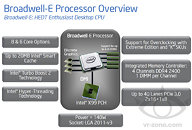Wednesday, October 22nd 2014

Intel Core i7 "Broadwell-E" HEDT Chips Arrive in 2016
Intel is beginning to put out the first details of its next high-end desktop (HEDT) processors, internally. Codenamed "Broadwell-E," the company's next Core i7 HEDT chips will be built in the existing LGA2011v3 package, and will be compatible with existing motherboards based on Intel's X99 Express chipset (with BIOS updates). Much like "Ivy Bridge-E" was to "Sandy Bridge-E," these chips will introduce only incremental updates, and nothing major, in terms of architecture.
To begin with, Core i7 "Broadwell-E" will be built in the 14 nanometer silicon fab process, and will feature 6 to 8 cores based on the "Broadwell" micro-architecture. These cores will be cushioned with up to 20 MB of L3 cache. The chip is pin-compatible to "Haswell-E," and so its I/O will be identical, featuring a quad-channel DDR4 integrated memory controller. One difference is that Intel may can the 28-lane PCIe approach with the entry-level part; or at least it doesn't find mention on the slide. If it's true, all parts based on this silicon, will feature 40-lane PCIe interfaces. The TDP of these chips will be rated at 140W. Intel is expected to launch the Core i7 "Broadwell-E" in 2016.
Source:
VR-Zone
To begin with, Core i7 "Broadwell-E" will be built in the 14 nanometer silicon fab process, and will feature 6 to 8 cores based on the "Broadwell" micro-architecture. These cores will be cushioned with up to 20 MB of L3 cache. The chip is pin-compatible to "Haswell-E," and so its I/O will be identical, featuring a quad-channel DDR4 integrated memory controller. One difference is that Intel may can the 28-lane PCIe approach with the entry-level part; or at least it doesn't find mention on the slide. If it's true, all parts based on this silicon, will feature 40-lane PCIe interfaces. The TDP of these chips will be rated at 140W. Intel is expected to launch the Core i7 "Broadwell-E" in 2016.

59 Comments on Intel Core i7 "Broadwell-E" HEDT Chips Arrive in 2016
1: Price increase on the base chip
2: Base chip is the only 6 core in the lineup with the others becoming both 8 cores
That of course is only my speculation.
Past actions are the best indication of future actions IMO. The one thing that Intel has done "consistently" with the entry level HEDT processor offering throughout the generations is be "inconsistent".
For example:
Core i7 3820 - didn't receive the "K" designation and was often referred to as partially unlocked. while it had the 40 PCIe lanes it was only quad core and the other two Sandy Bridge-E processors were 6 cores.
Core i7 4820K - The Ivy Bridge-E entry level chip was much the same as the 3820 but this time presumably actually deserving of the "K" suffix and thus fully unlocked.
Core i7 5820K - Finally 6 core / 12 threads and fully unlocked but a somewhat truncated 28 PCIe lanes.
What is clear is that Intel wants to limit, impede or gimp the entry level processor in a significant way but they just seem undecided as to how to do it. So they keep experimenting with the variables.
I expect some change in the entry level Broadwell-E processor. Although it would be nice if they upped the PCIe limit to something like 32 lanes at least,....assuming they don't go for the full 40.
Why do they want to limit and why do they want to be late with these push-outs?
Depends on you, actually, on all of us!
Am I reading that right that it has half the DIMMs (4 versus 8) compared to the Haswell-E chips? Why would they do that?
And 2016 is quire alright, Haswell-E doesn't deserve to be around for less than a year.
I guess DRAM prices are also back to normal by then...
They always mention TDP, not necessarily power consumption.
TDP: Thermal Design Target.
Wouldn't you be disappointed when 1/3 of your CPU does absolutely nothing and simply wasting space?